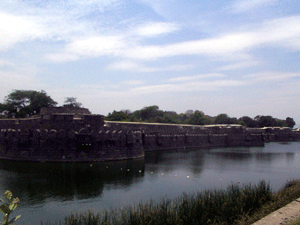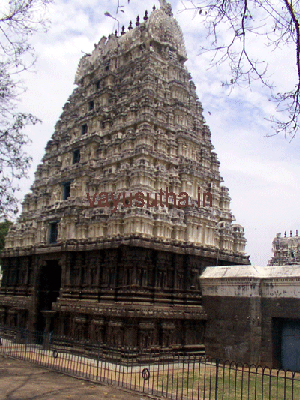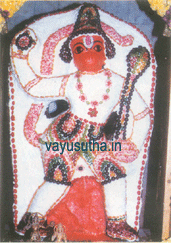Vellore
Vellore is the administrative headquarters of Vellore District, situated nearly one hundred forty km from Chennai city on the way to Bangalore and lies on the banks of the River Palar. Since the topography of this town is that there are hills on one side and a river on the other side and thus the town is naturally protected. Since the place is also strategically located, in the past all kingdoms trying for supremacy in the region wanted to bring this place under their rule. This town was thus under the sway of various dynasties and rulers, namely Pal lavas, Cholas of Uraiyur, the Rashtrakutaa dynasty of Malkhed, Sambuvarayar, the rulers of Vijayanagar, Marathas, and the Nawabs of the Carnatic and the British. In the 18th Century Vellore District was the scene of some of the decisive battles fought in Ambur (1749 AD) Arcot (1751 AD) and Vandivasi (1760 AD) as a result of the long-drawn struggle between the English and the French for Supremacy.
Vellore fort
 As seen above, the rulers wanted to fortify the place and as a result, a fort was built, firstly by
Sambuvarayars during the 13th century and the same was further strengthened by other rulers than
after. This ancient Fort is the only living fort in south India with a moat etc. Dating back to the
13th Century this ancient Fort is the main attraction for tourists. This historically famous fort
built on 136 acres and rectangular retains its past glory with its ramparts, battlements, turrets,
posts, and sally gates and with perennial water supply. Double walls fortify it and the main walls are
of made massive granite blocks laid one over the other without using mortar. The fort is one of the
most perfect specimens of Military architecture in South India. The fort houses a church,
Jalakantesvarar Temple, and many buildings. Many Government offices are located in these buildings.
As seen above, the rulers wanted to fortify the place and as a result, a fort was built, firstly by
Sambuvarayars during the 13th century and the same was further strengthened by other rulers than
after. This ancient Fort is the only living fort in south India with a moat etc. Dating back to the
13th Century this ancient Fort is the main attraction for tourists. This historically famous fort
built on 136 acres and rectangular retains its past glory with its ramparts, battlements, turrets,
posts, and sally gates and with perennial water supply. Double walls fortify it and the main walls are
of made massive granite blocks laid one over the other without using mortar. The fort is one of the
most perfect specimens of Military architecture in South India. The fort houses a church,
Jalakantesvarar Temple, and many buildings. Many Government offices are located in these buildings.
Sambuvarayar dynasty
The name Sambuvarayar can be split into Sambu+Araiyar. Araiyar is one of the categories in the Chola army. They were the followers of Lord Siva or Sambu the name which they had prefixed to their community name Araiyar and called themselves Sambuvarayars. They gained prominence and started acting as independent chieftains. The first king who established the dynasty was Rajakula Sambuvarayar (1236-1268AD) with Padaivedu (Padavedu) a place near Polur as the capital. The Vellore region came under the rule of Sambuvarayars of the Padavedu for about two centuries and they were the lords of the region. They have not only built many temples but also endowed them with gifts which we came to know from inscriptions found in and around Vellore. The first stage of the construction of the Jalakantesvarar temple and the Fort took place during their period.
Sambuvarayars and Sri Anjaneya Swamy
 A close look at the establishment of Padavedu as their headquarters with Sri Anjaneya guarding the
place in all directions and the legend of the place will give us an idea the influence of Sri Anjaneya
on the Sambuvarayar kings. For full details about the place Padavedu please see “ Sri Veera Anjaneya Temple,
Padavedu,", Thriruvanamalai Dist, Tamil Nadu”. Therefore it is no wonder that
there was a presence of worshiping Sri Anjaneya in this town from the13th centaury itself. After
Sambuvarayars this place came under the rule of the Hoysalas, Vijayanagar kings and Marathas till the
end of the 17th century, who were also worshipers of Sri Anjaneya Swamy.
A close look at the establishment of Padavedu as their headquarters with Sri Anjaneya guarding the
place in all directions and the legend of the place will give us an idea the influence of Sri Anjaneya
on the Sambuvarayar kings. For full details about the place Padavedu please see “ Sri Veera Anjaneya Temple,
Padavedu,", Thriruvanamalai Dist, Tamil Nadu”. Therefore it is no wonder that
there was a presence of worshiping Sri Anjaneya in this town from the13th centaury itself. After
Sambuvarayars this place came under the rule of the Hoysalas, Vijayanagar kings and Marathas till the
end of the 17th century, who were also worshipers of Sri Anjaneya Swamy.
Rule of Sultanates and Britishers
Beginning 18th century the town came under the rule of the Sultanates and then under the Britishers. It was a war-torn town during this time with lots of military activities. The establishment had no time to devote to the welfare of the people and the place. The worship in the biggest temple which is inside the fort in the town Sri Jalakantesvarar Temple was not being conducted, for all good reasons it could be assumed that there was a discontinuity and maybe it was during this time.
Sri Anjaneya vigraha in ‘Kotai medu’
To protect the deity, during the slaughter many vigrahas of Hindu Gods were thrown into the waters of the fort’s moat. At the beginning of the 20th century, when peace returned to the town, one Sri Sanjivi had found a vigraha of Sri Anjaneya in the waters of the fort's moat. The vigraha was brought out of the water and with proper guidance of elders and pundits, the vigraha was installed in a place called ‘Kotai medu’. A temporary shed was erected for the deity Sri Anjaneya Swamy and regular worship was conducted.
To protect the deity, during the slaughter many vigrahas of Hindu Gods were thrown into the waters of the fort’s moat. At the beginning of the 20th century, when peace returned to the town, one Sri Sanjivi had found a vigraha of Sri Anjaneya in the waters of the fort's moat.
Shifting the deity of Sri Anjaneya Swamy
After a few years for the reasons best known to Sri Anjaneya Swamy, a few people started to feel that this was not the proper place for the temple and needed to be shifted out of that place. Few employees of the Municipal Corporation who were regulars to the temple and devotees of Sri Anjaneya Swamy thought otherwise. But wise prevailed upon them and they decided that the deity of Sri Anjaneya Swamy would be shifted to the Municipal Corporation office complex itself. Under the leadership of Sri Swaminathan, the Devotees of Sri Anjaneya Swamy took initiative to this effect.
Temple for Sri Anjaneya Swamy
 Sri Hanuman devotees installed the murti of Sri Anjaneya Swami brought from Kotai medu temporally in
the southeast corner of the municipal office on an auspicious day in the year 1960. A thatched shed
was erected for the purpose. The faith in the Deity of Sri Anjaneya attracted the regulars of the
temple in Kotai medu to visit Him in this place. The employees of the municipality showed their
generosity by slowly improving the conditions of the temple. The temple does not have any
gopuram or vimanam for the deity even today. But the temple attracts large devotees of
Sri Anjaneya from in and around Vellore town.
Sri Hanuman devotees installed the murti of Sri Anjaneya Swami brought from Kotai medu temporally in
the southeast corner of the municipal office on an auspicious day in the year 1960. A thatched shed
was erected for the purpose. The faith in the Deity of Sri Anjaneya attracted the regulars of the
temple in Kotai medu to visit Him in this place. The employees of the municipality showed their
generosity by slowly improving the conditions of the temple. The temple does not have any
gopuram or vimanam for the deity even today. But the temple attracts large devotees of
Sri Anjaneya from in and around Vellore town.
Sri Anjaneya Swamy
The deity of this temple is an ancient one, which can be seen from the fact it resembles that of Gali Sri Anjaneya Swami of Mysore Road, Bengaluru which is a Sri Vyasaraja pradeshta. Only that the murthi here is comparatively small. Sri Hanuman of this kshetra is also a yathurmuki i.e., he is facing the devotees directly with both eyes. The tail of Lord is seen raised above and at the end of the tail is a bell. The Lords' left hand is seen resting on the hip and holding the lotus flower. His right hand is in abhya mudra offering the quality of nirbhayathvam to all His devotees. While the Lord is seen with all ornaments the small knife in the casing which adores His right hip as an ornament only adds beauty to the Lord.
Location of the temple: "Sri Veera Anjaneya Temple, Municipal complex, Vellore"
Experience
Offer your prayer to the Lord who was in ‘jala vasam’ for many years like Sri Jalakantesvarar of this kshetra had. He will water down all your worries and bestows ‘mangalm’.
SRI HANUMAN THINKS DIFFERENTLY, THINKS FAST
THINKS AHEAD AND ACTS FOR SURE
Ed [June 2013]
Updates: [Jan 2025]
